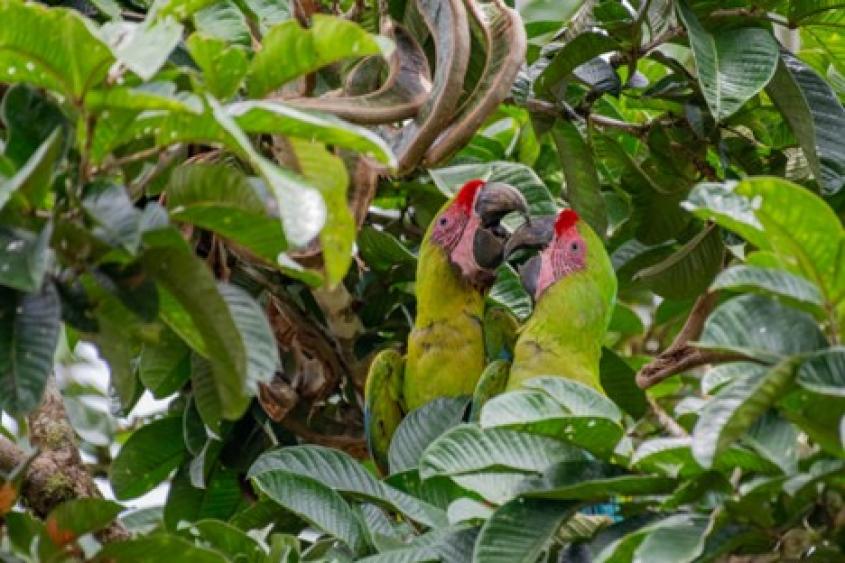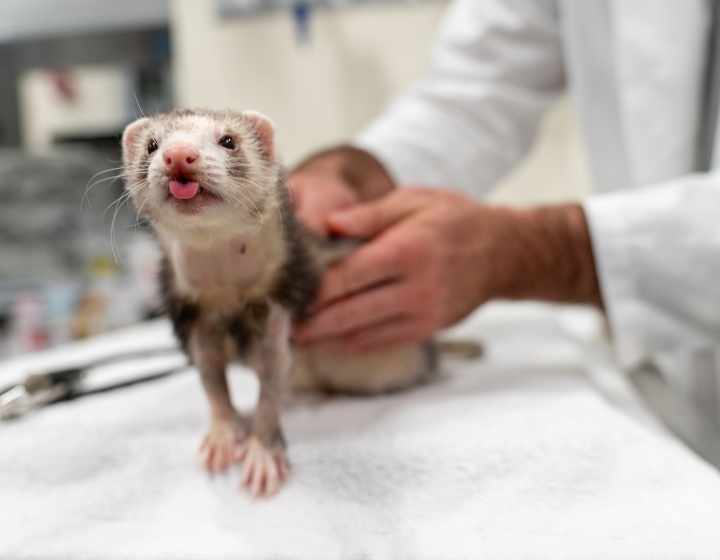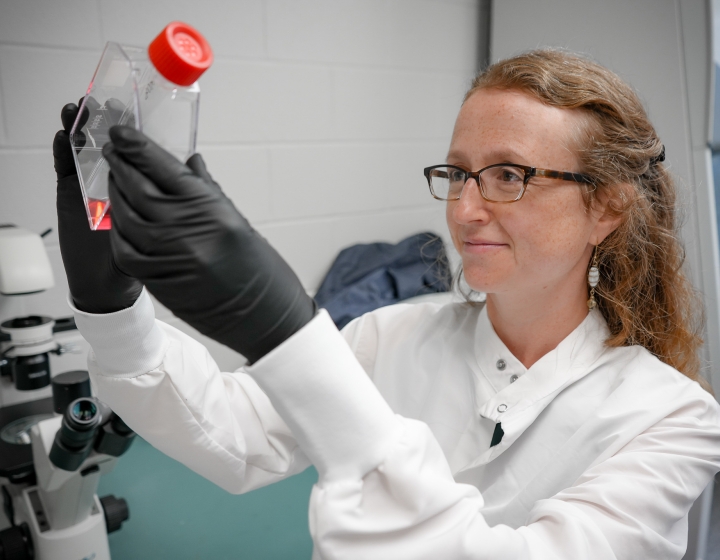Students in the field: Saving the great green and scarlet macaws
Anyone who knows me will know that I am an avid bird lover. From backyard chickens to falconry raptors, I love them all. But one group of birds holds a special place in my heart: the psittacines, more commonly known as the parrot family. With their intelligence that rivals that of primates and their highly complex social structures, these birds are nothing short of intriguing and captivating. So, when my mentor, Dr. Keila Dhondt, proposed that I work with a parrot conservation organization overseas during my third year, I leapt at the opportunity. Through the Cornell University College of Veterinary Medicine’s Expanding Horizons Program, I was able to apply for funding and schedule my trip during my third year distribution (elective) period.

The organization that welcomed me was the Macaw Recovery Network (MRN), formerly known as the Ara Project, located in picturesque Costa Rica. The mission of the MRN is to restore local native populations of Great Green Macaws and Scarlet Macaws in the Americas. These macaws are some of the most recognizable parrot species in the world, with their vibrant plumage, brilliant intelligence, and compelling charm. However, their numbers have been rapidly declining due to a multitude of reasons. The illegal pet bird trade is still prevalent in many regions worldwide, and Central America is no exception. Nestling parrots are taken from their nests by poachers and smuggled overseas, including the United States, to be sold as pet birds. Historic deforestation has also contributed to the population decline of macaws. Between 1940 and 1990, over half of Costa Rica’s forest cover was lost, leaving macaws without their preferred native species of tree nuts and nesting habitats. To complicate matters, macaws have a slower reproductive cycle compared to other birds. Their breeding season in Costa Rica is between December and June. Females lay clutches of two to three eggs that must be incubated for 30-35 days, and chicks only leave the nest at about 20 weeks old. They stay with their parents as juveniles and become sexually mature after five or six years. Thus, it is more difficult for macaws to maintain their breeding population compared to other birds who reproduce and mature more quickly.
The MRN envisions a future in which parrots and their ecosystems thrive and coexist with local communities, and they work towards this goal with a multifaceted approach. The organization consists of field teams who monitor nests in the wild, outreach teams who connect with local communities, and the captive breeding team, who I worked most closely with.
The Wild Macaw Reserve and the Captive Breeding Center, located in Punta Islita, houses over 100 Scarlet and Great Green Macaws. They have a small population of previously released macaws, breeding pairs, education ambassadors, and juvenile macaws being trained for release. Looking after these birds is a dedicated team of staff, volunteers, and interns from all over the world. Immediately upon arriving on site — as I was welcomed with open arms and freshly baked brownies—I knew that I had made the right decision coming to Costa Rica.

Right away, I met with Dr. Maria Sol Delechuk (Sol), the onsite bird manager and veterinarian. Prior to my trip, Dr. Dhondt, Sol and I had discussed the need to evaluate the breeding center birds for any potential blood parasites. Since I already had experience working on avian hematology and parasitology with Dr. Dhondt, many of the skills needed were familiar to me. Blood parasite load was an important health issue to consider, given the combination of a recent increase in mosquitoes and some new infertility issues the MRN was experiencing. It has been established that blood parasite load is associated with decreased fertility in breeding birds, so this was something Sol and I wanted to investigate. Several breeding pairs had either failed to produce a clutch of eggs, laid infertile eggs, or had fertile eggs die during the incubation period. Mosquitoes are known to be vectors of several avian diseases, particularly avian malaria. My goal was to perform health assessments and analyze samples under the microscope to search for any blood parasites or evidence of other infections. The birds included in the analysis consisted of mostly juvenile Great Green Macaws that the MRN is planning to release next year. Since the birds must be in peak health condition for release, it was especially paramount that we perform health assessments to rule out systemic disease.
During my time working with the captive breeding team, I was surprised numerous times by their kindness and willingness to go out of their way to support a project to assess the birds’ health. Examining these critically endangered birds while minimizing stress was no easy feat. These birds did not interact with people daily since they were being trained for release, and their flight skills were exceptional. Thus, it was imperative that everyone communicated well and had a seamless workflow. The maintenance staff took time out of their busy day to adjust the spacious aviary housing so we could use one side for birds already evaluated, and the other for birds to be examined. The interns began their morning feeding and cleaning duties early so they would have time to assist setting up our clinical supplies in the aviary. I was able to work directly alongside the veterinarian and received extremely helpful pointers along the way. Thanks to a supportive and experienced team, we were able to efficiently complete the health assessments on each bird. After thorough microscopic analysis of each sample, we concluded that all birds were free of detectable hemoparasites, and their bloodwork was within normal limits. This was a great finding for the team, and we were most likely able to rule out one possible cause for the breeding flock’s infertility since all birds share the same living space.
What left the most lasting impression on me was not just the clinical skills I gained. It was immersing myself in a new culture, with new lifelong friends, decadent food and gorgeous sights. It was such a turn from my busy life in wintery Ithaca, and prior to my trip, I never would’ve thought the lifestyle itself would impact me to this degree. Living in a tropical forest, I felt so in tune with nature and the birds I had the honor of working with. Every morning, we would be in the aviaries cleaning and feeding by 5:30am. Afterwards, we would have a short meeting to update each other about any changes in the birds. Following a communal breakfast, we got straight to work on various tasks — chopping down trees to create new perches, examining macaw chicks to ensure they were developing properly, checking nest boxes to candle eggs, and more. I split my time between helping the interns with their daily tasks and analyzing blood smears at the clinic. I also had the opportunity to attend lectures hosted by other MRN officials and learned about operating conservation centers and managing NGOs. Lunch breaks overlapped with the hottest hours of the day to avoid heatstroke, and many of us took that opportunity to cool off in the ocean. We finished work just before sunset as the birds were preparing to roost for the night.

The evenings were spent bonding with the interns. Even though we lived onsite and were in an extremely remote location, we were never bored. I experienced many things for the first time, from bonfires on the beach, to foraging for tropical fruit, to dancing traditional Costa Rican cumbia at village gatherings. A highlight was going to the beach on my last night to search for bioluminescence. The interns had warned me that so far, their trips had been unsuccessful. The one time I accompanied them, we were greeted with breathtaking glittering blue waves against the full moon — what an unforgettable moment!
Although my time in Costa Rica was short, it was a trip filled with rich memories and lessons I will never forget: How to remain calm when examining a Great Green Macaw who could’ve easily bitten my fingers off. How to use a machete for anything from fashioning perches to opening coconuts. How to catch a good wave just before it breaks. I will always remember the exhilaration of seeing a pair of wild Scarlet Macaws soar above my head for the first time, the awe of gazing at the vermillion sunset as waves crashed onto the rocks below, and the giddiness of opening a nest box to find a newly hatched chick. My list of unforgettable moments is endless, and this entire experience is something I will treasure forever. It would not have been possible without the support from Cornell’s Expanding Horizons International education program, my mentor Dr. Keila Dhondt, and the entire team at the MRN. As I returned to Ithaca to prepare for my fourth year, I came back with new clinical skills, a newfound appreciation for wildlife conservation and the intricacies of managing an organization, and a strengthened passion for the incredible avian species we must fight to protect.

Mio Ito, Class of 2024, is a D.V.M. student at the Cornell University College of Veterinary Medicine. She graduated with a B.S. in Biological Sciences from Binghamton University in 2020. Her interests include exotic pet and wildlife medicine, with an emphasis on avian species. She hopes to contribute to clinical research that enhances the quality of care for wildlife and exotic animal species.





